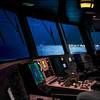NASSCO Starts Third T-AKE Ship
Graham Dodd, NASSCO’s Director of Steel, and Mike Trimble, Military Sealift Command (MSC) Ship’s Project Manager, pose with Navy Captain Mike Stanton, Commanding Officer, Supervisor of Shipbuilding, and Mrs. Jennifer Stanton, who made the first cut on the ship’s first steel plate to signify the start of construction of the T-AKE 3.
National Steel and Shipbuilding Company began construction on the third ship in the T-AKE program, a new class of combat logistics force ships designated the Lewis and Clark class. Mrs. Jennifer Stanton, wife of U.S. Navy Captain Mike Stanton, Commanding Officer, Supervisor of Shipbuilding, Bath, Maine, made the first cut on the ship’s first steel plate to signify the start of construction. Captain Stanton’s San Diego detachment is responsible for overseeing construction on the T-AKE program. The U.S. Navy has awarded NASSCO contracts for eight dry cargo/ammunition ships and holds options for an additional four ships. If all the options are exercised, the 12-ship program would have a total value of $3.7 billion and become the largest contract in NASSCO’s history.
The contracts will provide sustained employment for 1,500 to 1,800 NASSCO employees and contribute millions of dollars per year in payroll, tax revenues and purchases from local suppliers during the life of the contract, which could run through 2010.
The first T-AKE, named the Lewis and Clark to honor the two legendary explorers who led an expeditionary force from 1804 to 1806 to explore the American West, was launched on May 21, 2005. The ship is in the final stages of construction alongside NASSCO’s pier, with delivery scheduled for early next year. The second T-AKE, to be named the Sacagawea in honor of the Shoshone Indian woman who acted as guide and interpreter for Lewis and Clark, is scheduled to be launched in the spring of 2006.
The T-AKEs are 210 meters (689 feet) in length and 32.2 meters (105.6 feet) in beam, with a design draft of 9.12 meters (29.9 feet). The ships will carry almost 7,000 metric tons of dry cargo and ammunition and 23,500 barrels of cargo fuel. The T-AKEs will be the first modern Navy ships to combine proven international marine technologies such as an integrated electric-drive propulsion system that can achieve a speed of 20 knots, and commercial design features that will minimize their cost of operation and maintenance over their expected 40-year lives.










